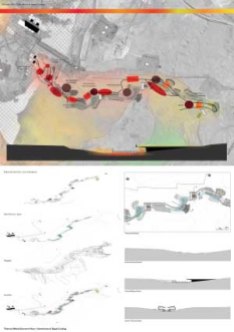Energy is the basis of life and the fuel for modern civilization. The energy industry can be reconsidered by uncovering where operations can overlap and hybridize with other infrastructures, economies, and ecologies. Energy Afterlife explores the reutilization of geothermal effluent from Reykjanes Geothermal Power Plant in southwest Iceland. Reusing its residual energy creates a post-production, spin-off process that yields a new landscape formed by thermal principles and the compression and extension of its temperature gradient. Algae cultivation and production, revegetation strategies, and temperature’s experiential qualities are interwoven to form a thermal resource park. Heat is reexamined as an invisible, phenomenological design material, which can be captured, contained, and released through conduction, convection, and radiation properties and techniques inherent in particular materials and forms.
The Reykjanes Geothermal Power Plant, opened in 2006, uses 15 boreholes to withdraw 300°C thermal brine from 1.6 ~ 3km below grade. This critically hot water passes through steam separators, which extract water and minerals before the steam is sent to the turbines. Thermal brine effluent is 190°C after the purification process, and is piped to a cooler where it is mixed with 8°C sea water to reduce its temperature before disposal. At 57°C, the effluent is sent down an 800m long concrete culvert and released to the Atlantic Ocean at a rate of 4,000 liters per second.
Energy Afterlife repurposes this effluent instead of discarding it. The temperature gradient can be used as a thermal device in the landscape to create micro-habitats, climates, ecologies, and economies.
Energy Afterlife proposes an alternative methodology for using geothermal energy by exploiting the thermal gradient, decentralizing the network of energy use, and seizing every opportunity for programming across multiple temperature scales — thereby moving towards a visible hybridization of industrial, ecological, and cultural processes. The variable uses of thermal gradients in relationship to multiple programs are manifested as Thermal Worlds, assigning meaning to temperature. This is highlighted in two particular Worlds. Extreme Heat creates a territory whose heat is experienced from a distance, through radiation and conduction. Heat in the form of radiation is captured and transferred with the use of materials. In contrast, Extreme Algae is a world whose temperatures, which are optimal for all programs to occur, are stretched and retained across a large swath of land.
Water is an element essential to Icelanders’ cultural identity. In Energy Afterlife, the material of geothermal water is both medium and subject, in all of its states and temperatures. It engages the senses and invites visitors to consider its thermal gradient: its effects, its texture, and the way it generates a natural process of making and a new cultural process of gathering, transporting, and arranging the heated material. The new landscape is a rare geothermal saline environment, interwoven with opportunities for research, education, and recreation. A landscape of Energy Afterlife is formed: effluent waste is reused and repurposed, becoming a spin-off from a residual geothermal energy production process.
Excerpt from 3/13 Article in “Landscape Architecture Frontiers” To download a PDF of the article, please go to the LAF website.












